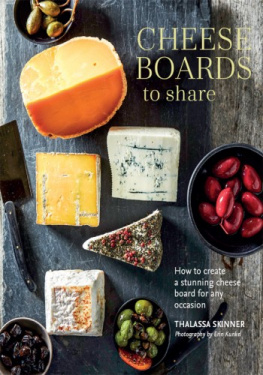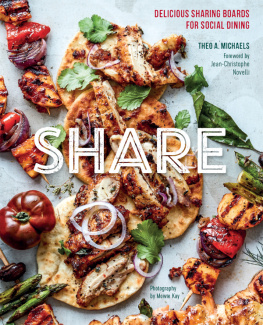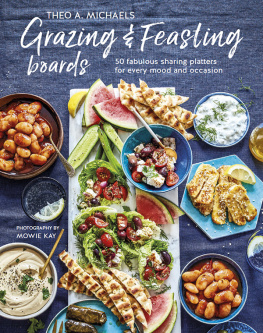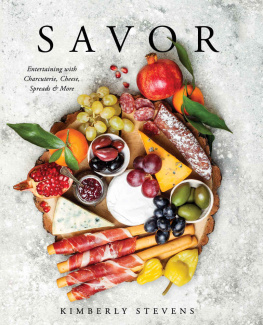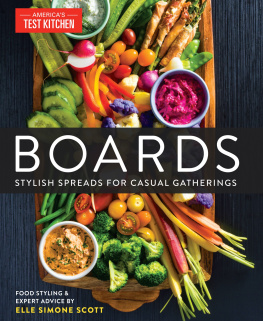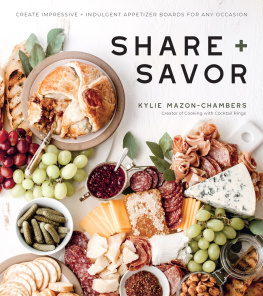CHEESE BOARDS
to share

How to create a stunning cheese
board for any occasion
THALASSA SKINNER
Photography by Erin Kunkel

For Ricardo Huijon, the ying to my yang.
No matter what I do in cheese,
you are always by my side.
Art Director Leslie Harrington
Design Assistance Emily Breen
Commissioning Editor Alice Sambrook
Editorial Director Julia Charles
Production Gordana Simakovic
Publisher Cindy Richards
Food and Prop Stylist Valerie Aikman-Smith
Indexer Hilary Bird
Illustrator Cathy Brear
Published in 2019 by
Ryland Peters & Small
2021 Jockeys Fields
London WC1R 4BW
and
341 East 116th Street
New York, NY 10029
www.rylandpeters.com
10 9 8 7 6 5 4 3 2 1
Text Thalassa Skinner 2019
Accompaniment recipes Valerie Aikman-Smith 2019
Design, illustration and photography
Ryland Peters & Small 2019
The authors moral rights have been asserted. All rights reserved. No part of this publication may be reproduced, stored in a retrieval system or transmitted in any form or by any means, electronic, mechanical, photocopying or otherwise, without the prior permission of the publisher.
eISBN: 978-1-78879-252-3
ISBN: 978-1-78879-148-9
A CIP record for this book is available from the British Library. US Library of Congress CIP data has been applied for.
Printed in China
CHEESE TERMINOLOGY
Throughout this book youll see PDO and PGI after some of the European cheeses and cured meats. Protected Designation of Origin (PDO) and Protected Geographical Indication (PGI) means that the product is both protected and promoted by designating specific locations, production processes and quality controls that ensures what you are purchasing is genuine. There are bilateral agreements between countries worldwide that accept this, and it protects the reputation of regional foods, local food production and its economy, and ensures top quality.
There is also an appellation system in place for most of these foods (also used for beverages), but for the purposes of clarity, this book uses predominantly PDO and PGI for its protected designations. The main exceptions to this are the cheeses of Switzerland, which are promoted and protected by the French appellation AOP (Appellation dorigine protge). There is also Frances AOC (Appellation dorigine contrle), Italys DOC (Denominazione di origine controllata), Portugals DOC (Denominao de origem controlada), Spains DO (demoninacon de origen) and Romanias DOC (Denumire de origine controlata).
SAFETY NOTE
Pregnant women, young children, the elderly or those with a compromised immune system are advised not to eat any uncooked mold-ripened soft cheeses such as brie, camembert, chvre or others with a similar rind. Soft uncooked blue-veined cheeses such as Danish blue, gorgonzola and roquefort should also be avoided.
COOKS NOTES
Both American (Imperial plus US cups) and British (Metric) measurements are included in these recipes for your convenience. However, it is important to work with one set of measurements and not alternate between the two within a recipe. Ovens should be preheated to the specified temperatures. We recommend using an oven thermometer. If using a fan-assisted oven, adjust temperatures according to the manufacturers instructions. When a recipe calls for the zest of citrus fruit, buy unwaxed fruit and wash well before using. If you are only able to find treated fruit, scrub well in warm, soapy water before using.
Contents


Cheese makes people smile. Simply saying cheese leads to a grinning photograph and instantly lifts the spirits. Delicious, satisfying and with endless flavors and varieties, cheese is often the favorite food on the table. Yet, most people actually know very little about how it is made, the different styles and how to talk cheese. Deciding which cheese to buy is often accompanied with a shrug and eyes at half-mast. Its true that there are many, many cheeses out there. But this book will hopefully help to show you that this can be exciting rather than overwhelming.How, then, to be confident when putting together a cheese board? Above all else, be sure to let loose and have fun. If you are not having a good time, its likely your guests wont either. Youll find many helpful pointers here that will help to ensure your board is a hit. But the fun and personality you inject into the cheese board starts with you.Just like anything youre not sure about, ask for assistance if you need it. If a shop has a counter or a cool cabinet filled with cheese, there will likely be at least one person around who can lend a hand. Find a board you like in this book and take in the names of the cheeses on that board. If the shop doesnt have the same cheeses, thats fine. Let them guide you to appropriate alternatives. Almost all cheeses have similar siblings that can be substitutedand that is how you learn about other cheeses. Even if you have favorites, step out of your comfort zone and try something new every now and then.Not everyone has access to a cheesemonger, but if you do you are off to the best possible start. Dive in and befriend those folks! Theyll be halving wheels and cutting cheeses daily, so there will be random samples to try, plus they will be able to open up wedges that you are interested in for sampling. The best way to learn what you like is, of course, to taste (and smell).Most cheese counters place similar cheeses together so that you can navigate by eye when browsing. Cheese signs are incredibly helpful, and even the packaging on cheeses aims to make selection easier. A lot of effort goes into making them accurate and, often, fun. Read them carefully, learn and enjoy. Dont stress so much that you lose sight of the fact that youre choosing cheese for a happy occasion. It should be a pleasant experience, so smile, take your time and think about the end result: eating cheese!Milk, the wholesome, nutritious liquid naturally produced by females after giving birth is simple in its concept but wondrous in what it achieves. What mamas eat and the state of their health impacts the quality of their milk and, therefore, the cheese produced from it. Extreme care taken by farmers in raising and milking their animals is the foundation that every cheesemaker relies on. If the milk is not excellent, the cheese cannot be either.The main milk sources for cheesemaking are cows, goats, sheep and water buffalo. All cheesesfrom fresh, rindless cheeses to mozzarella, blue and cheddarcan be made from any of these milks. The skill of the cheesemaker comes into play when reckoning with the components of each milk type and its seasonality, in order to transform the liquid into a product that can be coagulated, formed, aged, eaten and enjoyed. Not a single step can be taken lightly; when 1000 pounds of the highest quality cows milk is to be made into 100 pounds of cheese, there is much at stake. Cheesemakers must know what they are doing and have planned exactly what they want that cheese to be before the milk warms in the vat.Making cheese is not hard but making good cheese consistently is difficult, requiring skill, dedication and meticulous attention to detail. The basic steps to cheesemaking include coagulating (which separates the solids from the liquids), adding specific molds/yeasts, cutting the curd (aka solids), manipulating the curd in different ways (such as heating, washing, pressing, hand-ladling), then salting and aging the cheese. Every step in the recipe impacts the texture and flavor of the cheese, and every cheese produced from a single vat is different, even if it is made exactly the same waywhich means it must be kept under careful watch.The younger the cheese, the higher the moisture content and the faster it needs to be eaten. Soft cheeses with delicate rinds owe much of their texture and flavor to the rind itself, which is actively growing on the surface of the cheese and should be eaten (or else youll be missing the point). Firmer and more aged cheeses, which cover a wide variety of styles, develop a mind-boggling spectrum of flavors due to the way that the milks components (specifically the butterfat and proteins) break down over time and the careful treatment of the wheels as they age (whether repeatedly washed with brine or moved to lower/higher temperature or lower/higher humidity, etc.).But nothing should mask or overpower the flavor of the milk itselfnot in any cheese. No matter what, the milk is key. Remind yourself of that as you create your cheese board, making sure the cheeses get top billing and are savored. Because they are not only agricultural products but crafted with care, with millennia of practice and tradition tied to their production.
Next page
